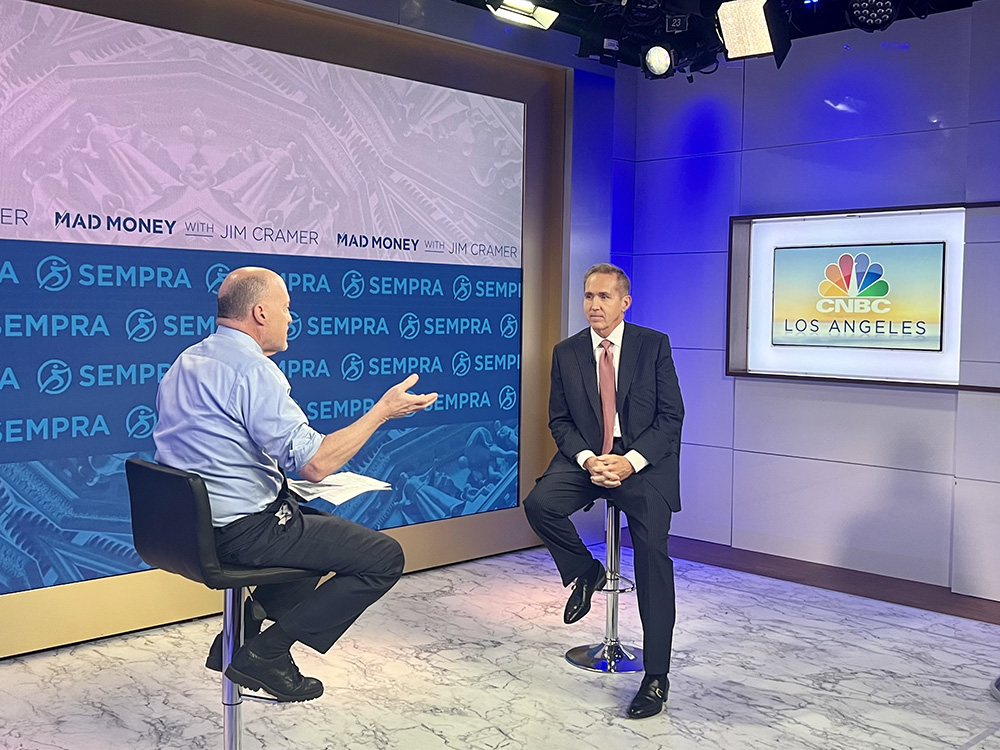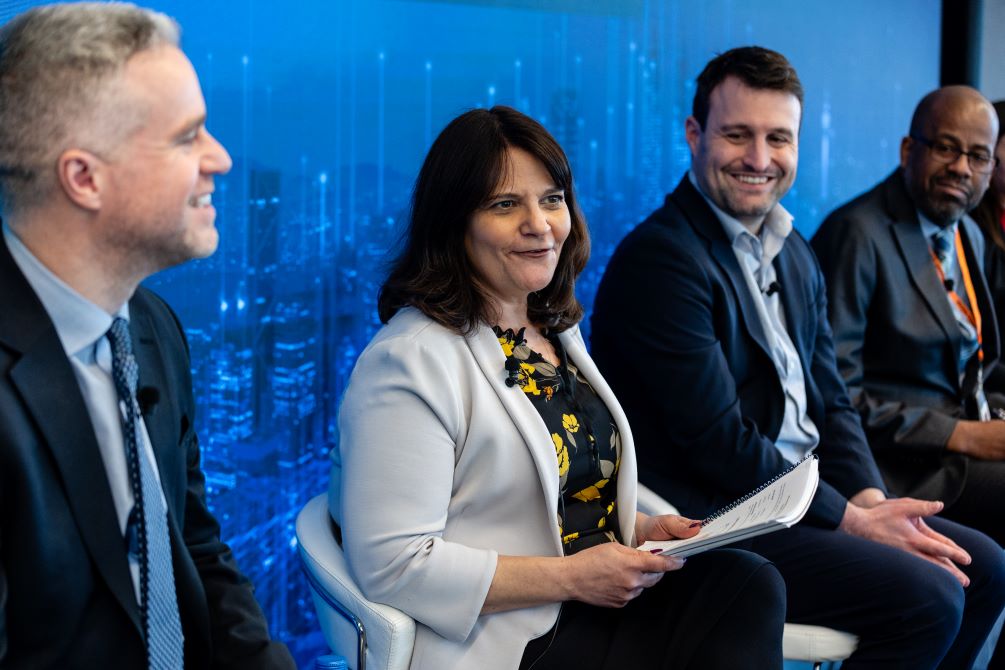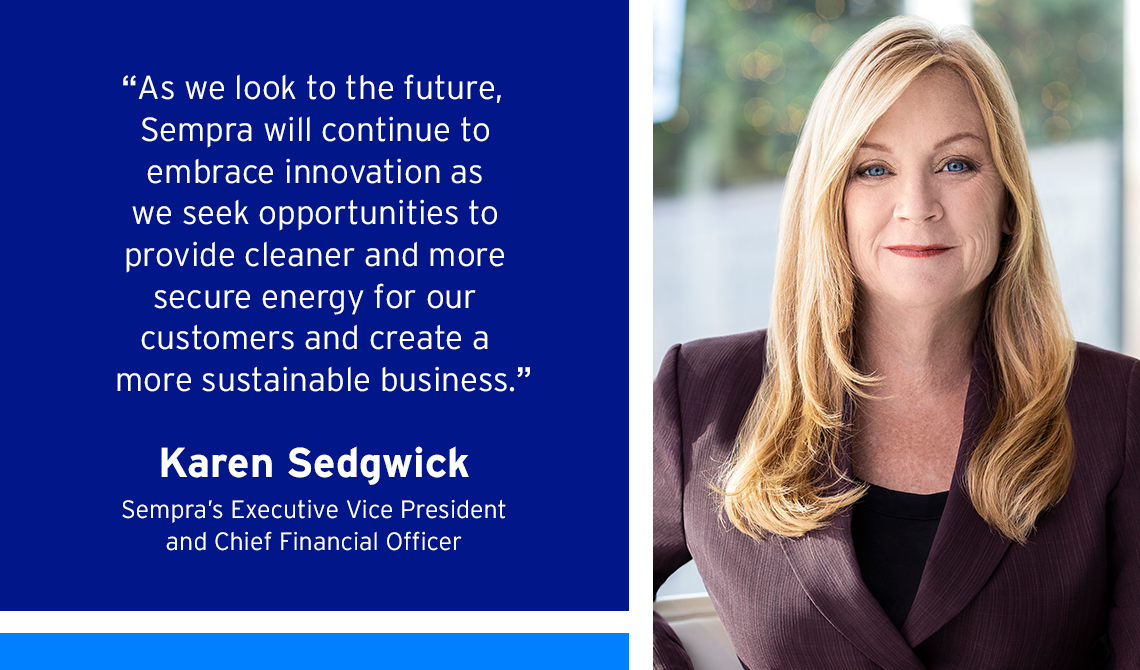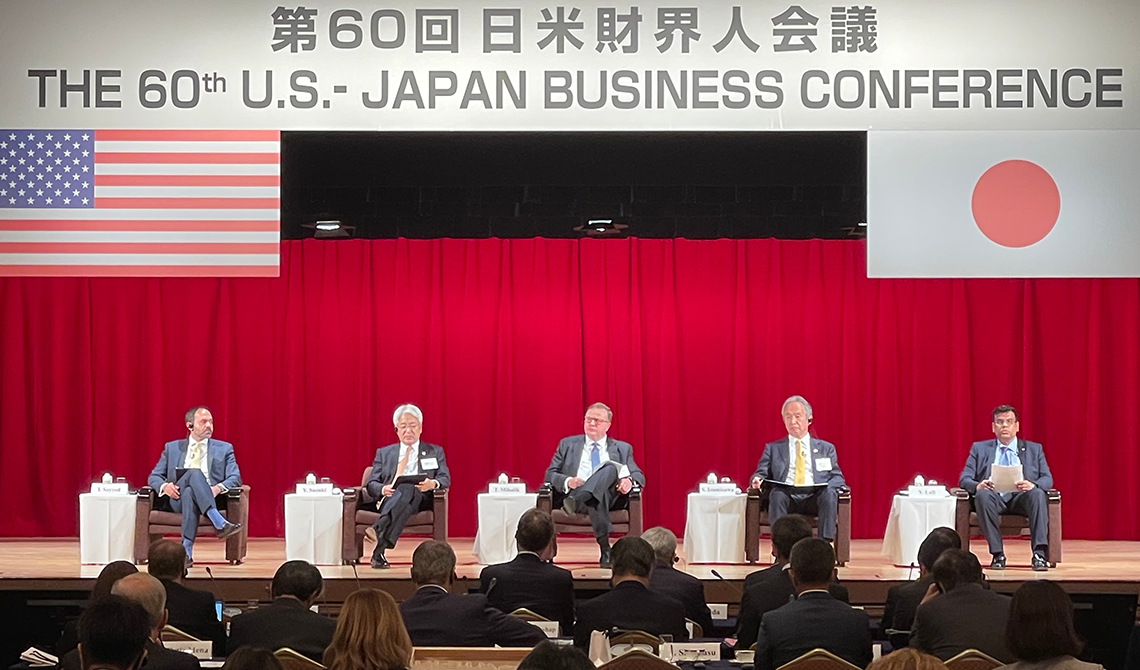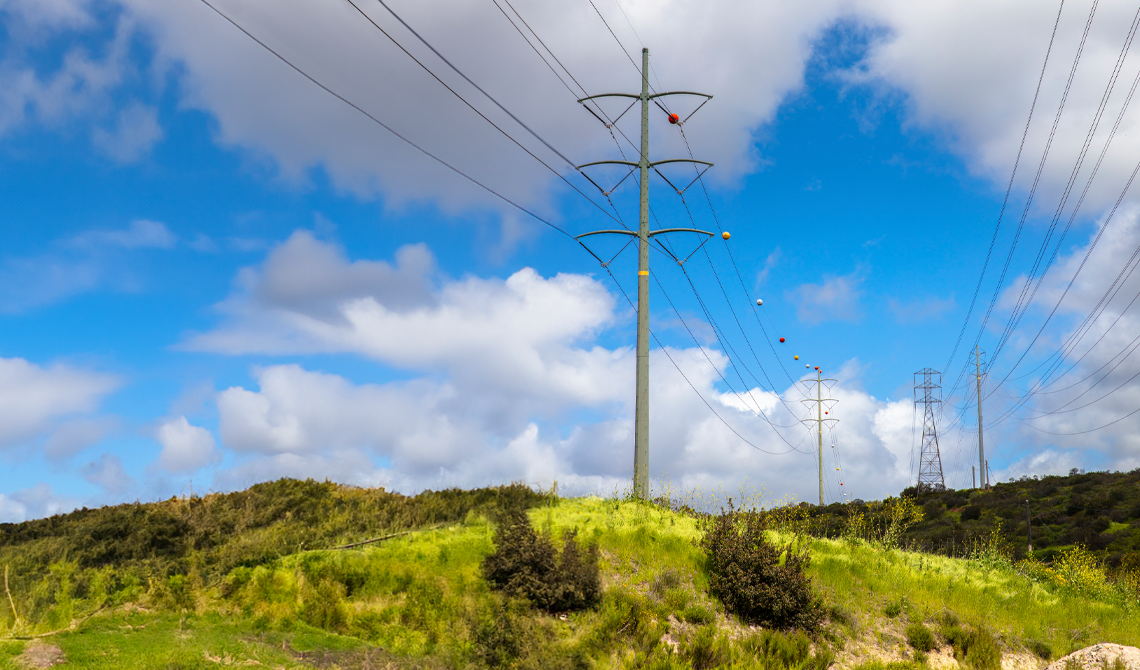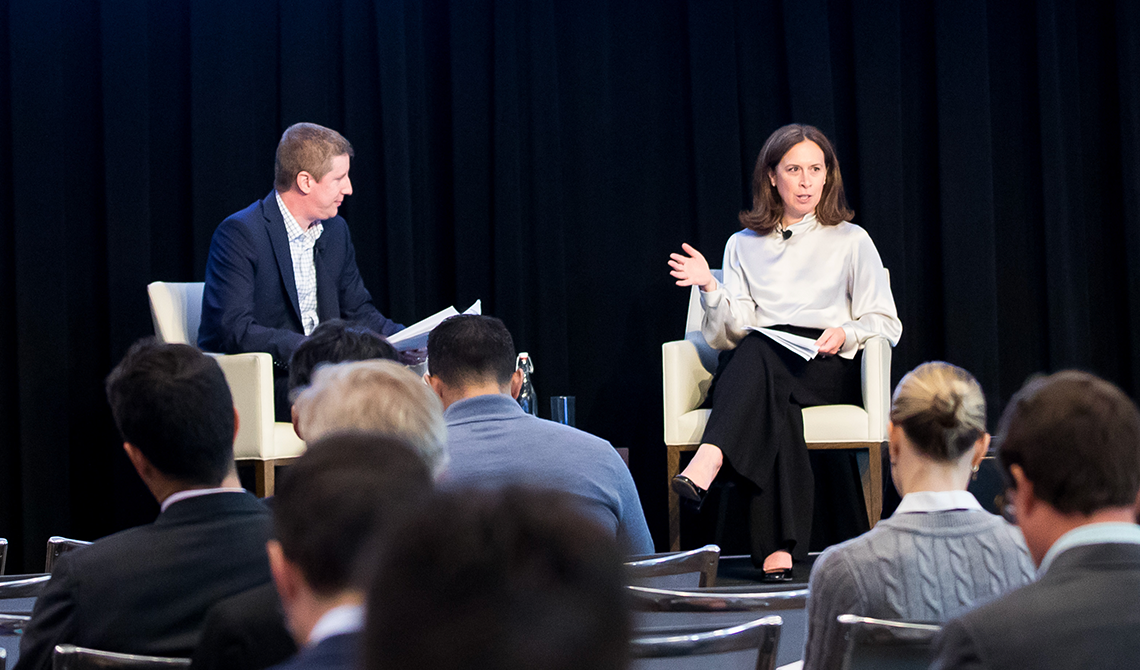In an interview in Los Angeles with CNBC host Jim Cramer, Jeffrey Martin spoke about Sempra’s three growth platforms, record $40 billion capital plan, ESG leadership and commitment to the service of others.
Sempra’s decision to simplify its business model to focus on developing energy infrastructure in some of the most attractive markets in North America is one reason the company is successful today, Jeffrey W. Martin, chairman and chief executive officer of Sempra, told Jim Cramer on CNBC’s “Mad Money” this week.
“By narrowing our business strategy and improving our capital discipline, it is paying dividends,” Martin said. “Over the last three years, we returned $5 billion to our owners in the form of share repurchases and dividends, while growing our adjusted earnings per share at roughly 10% annually.”
Today, that same strategy supports a record $40 billion, five-year capital plan, which includes underlying rate base growth at the company’s utilities of 9% annually through 2027.
“When you put that level of projected capital spending and growth together with the company’s current dividend yield of 3.2% — it creates what is potentially a very attractive growth and income opportunity for investors,” said Martin.
With the recent release of Sempra’s 15th annual Corporate Sustainability Report, Cramer also asked Martin about the company’s success in advancing sustainable business practices.
“What we’re trying to do is help America decarbonize the energy grid here at home and make sure, in foreign countries, as they adopt renewables and cleaner forms of energy, they can use complimentary fuels like natural gas to help them decarbonize more quickly,” said Martin. “Hydrogen is also expected to become a feedstock for industry and heavy-duty transportation. In the future, we think it’s going to be an important fuel source for our country.”
Closing the interview, Cramer asked Martin about his service in the U.S. Army.
“A lot of people focus on the discipline, teamwork and higher levels of responsibility that come with military service, but the key takeaway for me was the opportunity to serve an ideal greater than myself — it was an honor to work alongside so many incredible men and women from diverse backgrounds and all walks of life who shared a common love of country and purpose,” said Martin, a West Point graduate. “That same common purpose can be seen at Sempra as 20,000 talented employees work together to support our mission to build the leading energy infrastructure company in North America. To do that we have made a strong commitment to be a leader in sustainability and to invest in innovation and new technologies to better serve our stakeholders.”
This article contains statements that constitute forward-looking statements within the meaning of the Private Securities Litigation Reform Act of 1995. Forward-looking statements are based on assumptions with respect to the future, involve risks and uncertainties, and are not guarantees. Future results may differ materially from those expressed or implied in any forward-looking statement. These forward-looking statements represent our estimates and assumptions only as of the date of this article. We assume no obligation to update or revise any forward-looking statement as a result of new information, future events or otherwise. In this article, forward-looking statements can be identified by words such as “believes,” “expects,” “intends,” “anticipates,” “contemplates,” “plans,” “estimates,” “projects,” “forecasts,” “should,” “could,” “would,” “will,” “confident,” “may,” “can,” “potential,” “possible,” “proposed,” “in process,” “construct,” “develop,” “opportunity,” “initiative,” “target,” “outlook,” “optimistic,” “poised,” “maintain,” “continue,” “progress,” “advance,” “goal,” “aim,” “commit,” or similar expressions, or when we discuss our guidance, priorities, strategy, goals, vision, mission, opportunities, projections, intentions or expectations.
Factors, among others, that could cause actual results and events to differ materially from those expressed or implied in any forward-looking statement include risks and uncertainties relating to: California wildfires, including potential liability for damages regardless of fault and any inability to recover all or a substantial portion of costs from insurance, the wildfire fund established by California Assembly Bill 1054, rates from customers or a combination thereof; decisions, investigations, inquiries, regulations, issuances or revocations of permits, consents, approvals or other authorizations, renewals of franchises, and other actions by (i) the California Public Utilities Commission (CPUC), Comisión Reguladora de Energía, U.S. Department of Energy, U.S. Federal Energy Regulatory Commission, Public Utility Commission of Texas, and other governmental and regulatory bodies and (ii) the U.S., Mexico and states, counties, cities and other jurisdictions therein and in other countries in which we do business; the success of business development efforts, construction projects and acquisitions and divestitures, including risks in (i) being able to make a final investment decision, (ii) completing construction projects or other transactions on schedule and budget, (iii) realizing anticipated benefits from any of these efforts if completed, and (iv) obtaining the consent or approval of third parties; litigation, arbitrations, property disputes and other proceedings, and changes to laws and regulations, including those related to the energy industry in Mexico; cybersecurity threats, including by state and state-sponsored actors, of ransomware or other attacks on our systems or the systems of third-parties with which we conduct business, including the energy grid or other energy infrastructure, all of which have become more pronounced due to recent geopolitical events; our ability to borrow money on favorable terms and meet our obligations, including due to (i) actions by credit rating agencies to downgrade our credit ratings or place those ratings on negative outlook or (ii) rising interest rates and inflation; failure of foreign governments, state-owned entities and our counterparties to honor their contracts and commitments; the impact on affordability of San Diego Gas & Electric Company’s (SDG&E) and Southern California Gas Company’s (SoCalGas) customer rates and their cost of capital and on SDG&E’s, SoCalGas’ and Sempra Infrastructure’s ability to pass through higher costs to customers due to (i) volatility in inflation, interest rates and commodity prices, (ii) with respect to SDG&E’s and SoCalGas’ businesses, the cost of the clean energy transition in California, (iii) with respect to SDG&E’s business, departing retail load resulting from additional customers transferring to Community Choice Aggregation and Direct Access, and (iv) with respect to Sempra Infrastructure’s business, volatility in foreign currency exchange rates; the impact of climate and sustainability policies, laws, rules, regulations, disclosures and trends, including actions to reduce or eliminate reliance on natural gas, increased uncertainty in the political or regulatory environment for California natural gas distribution companies, the risk of nonrecovery for stranded assets, and our ability to incorporate new technologies; weather, natural disasters, pandemics, accidents, equipment failures, explosions, terrorism, information system outages or other events that disrupt our operations, damage our facilities or systems, cause the release of harmful materials or fires or subject us to liability for damages, fines and penalties, some of which may not be recoverable through regulatory mechanisms or insurance or may impact our ability to obtain satisfactory levels of affordable insurance; the availability of electric power, natural gas and natural gas storage capacity, including disruptions caused by failures in the transmission grid, pipeline system or limitations on the withdrawal of natural gas from storage facilities; Oncor Electric Delivery Company LLC’s (Oncor) ability to reduce or eliminate its quarterly dividends due to regulatory and governance requirements and commitments, including by actions of Oncor’s independent directors or a minority member director; changes in tax and trade policies, laws and regulations, including tariffs, revisions to international trade agreements and sanctions, such as those imposed in connection with the war in Ukraine, any of which may increase our costs, reduce our competitiveness, impact our ability to do business with certain counterparties, or impair our ability to resolve trade disputes; and other uncertainties, some of which are difficult to predict and beyond our control.
These risks and uncertainties are further discussed in the reports that Sempra has filed with the U.S. Securities and Exchange Commission (SEC). These reports are available through the EDGAR system free-of-charge on the SEC’s website, sec.gov, and on Sempra’s website. Investors should not rely unduly on any forward-looking statements.
Sempra Infrastructure, Sempra Infrastructure Partners, Sempra Texas, Sempra Texas Utilities, Oncor and Infraestructura Energética Nova, S.A.P.I. de C.V. (IEnova) are not the same companies as the California utilities, SDG&E or SoCalGas, and Sempra Infrastructure, Sempra Infrastructure Partners, Sempra Texas, Sempra Texas Utilities, Oncor and IEnova are not regulated by the CPUC.
